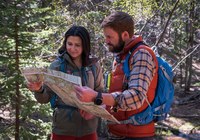Hiking Safety Handbook teaches the skills you need to hike responsibly and stay safe. Art Hogling, director of the CMC Hiking Safety Seminars, brings decades of experience and the latest research to bear on crucial safety topics.
Order your copy of Hiking Safety Handbook today!
*****
Wilderness travel can bring tremendous adventure and joy to life. But for the unprepared, the same backcountry experience can bring pain, fear, and in the worst-case scenario, even death. Education and experience are the key elements that keep the balance on the joy side of the equation. Wilderness safety education has been an important value of the Colorado Mountain Club (CMC) since its founding in 1912. Decades of classes, schools, field trips, and lectures have created a safety culture that has enabled safer outdoor experiences for generations of adventurers. This handbook has its origins in those classes.
BREAKING A CHAIN OF ERRORS
Risk managers studying accident records have identified a phenomenon that appears again and again in incident analysis. Experienced rescue personnel recognize it, and it shows up repeatedly in safety literature. It is a variously called the “chain of errors,” “the domino effect,” “the cascade of bad events,” or “the ripple effect.” Veteran mountain rescuer Mark Scott-Nash describes it as a “chain of seemingly unrelated incidents whose warning signs are not heeded.” Sandy Stott, accidents editor at the Appalachia Journal, describes it as “bit by bit, that is how a hurt happens,” and “the little increments which get us to a time and place where a whole slope lets go, or a cloud descends, when everything changes instantly.”
The warning signs can be “outer” or “inner” signs. Examples of “outer” signs are visual evidence of recent avalanche activity or an overwhelming verbal disagreement among team members. Examples of “inner” signs are your unease about conditions on the climbing route or the dynamics of the group, neither of which you can precisely put into words. Olympic champion gymnast Simone Biles courageously heeded inner warning signs when she withdrew from international competition in Beijing. Widely expected to win gold medals in her events, she said that she knew she should not attempt dangerous feats if her mental senses were exhibiting warnings. Skier Marc Peruzzi says, “If you aren’t feeling it . . ., which is to say if your head isn’t in the right place, it is best to back off.” Here are some examples of "outer" and "inner" warning signs:
You brought one quart of water but meant to bring two.
The quarrel you had with your spouse last night is preying on your mind. Your focus is not on the trail.
It is a clear day, and you got an early start. You’re several miles up the trail when the morning sun pops over a ridge, and you realize you left your sunglasses at home.
The mosquitoes are out in force. You do not have any bug repellant.
Your smartwatch, cell phone, or personal locator beacon indicate low battery power.
Showers occur, and your rain gear “wets out,” not repelling water and soaking through to your inner layers.
The trail requires you to cross a raging stream on a snowbridge or slippery fallen tree. You must recross the same stream upon return, when snowmelt will make it faster and deeper.
The trail is vacant of other hikers. When you do spot a person, they act strangely and dodge off the trail when spotting you.
You can’t remember if you locked your car and rolled up the windows.
You’re following “Leave No Trace” clothing guidelines by wearing dull green and gray clothing so you make less of a visual impact in the wilderness. You encounter dayglowclad hunters and remember it is hunting season.
You startle a large mammal that runs off into the brush. Five minutes later, you realize it has returned and is following you.
You brought your tent for your overnight trip, but you forgot your tent poles.
Safe hikers learn to tune in to an inner sense that things are starting to go wrong. Certain occurrences trigger subtle warnings, easily missed if you are not paying attention. Individually, any one of the events listed here is not enough to call it a day. But when you experience three or more, it is wise to back off your hike and save your adventure for another time.
 Sarah Gorecki
Sarah Gorecki
